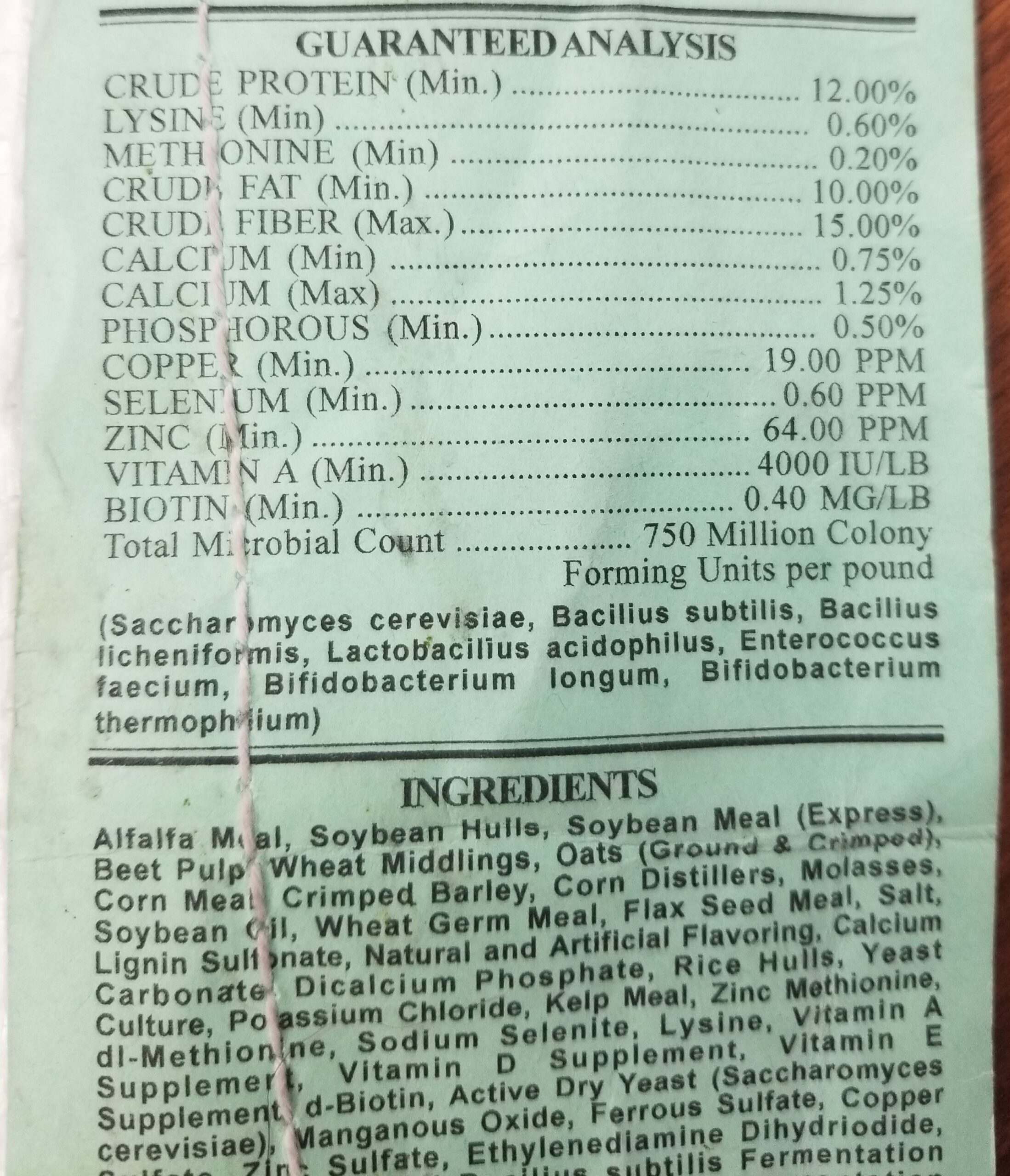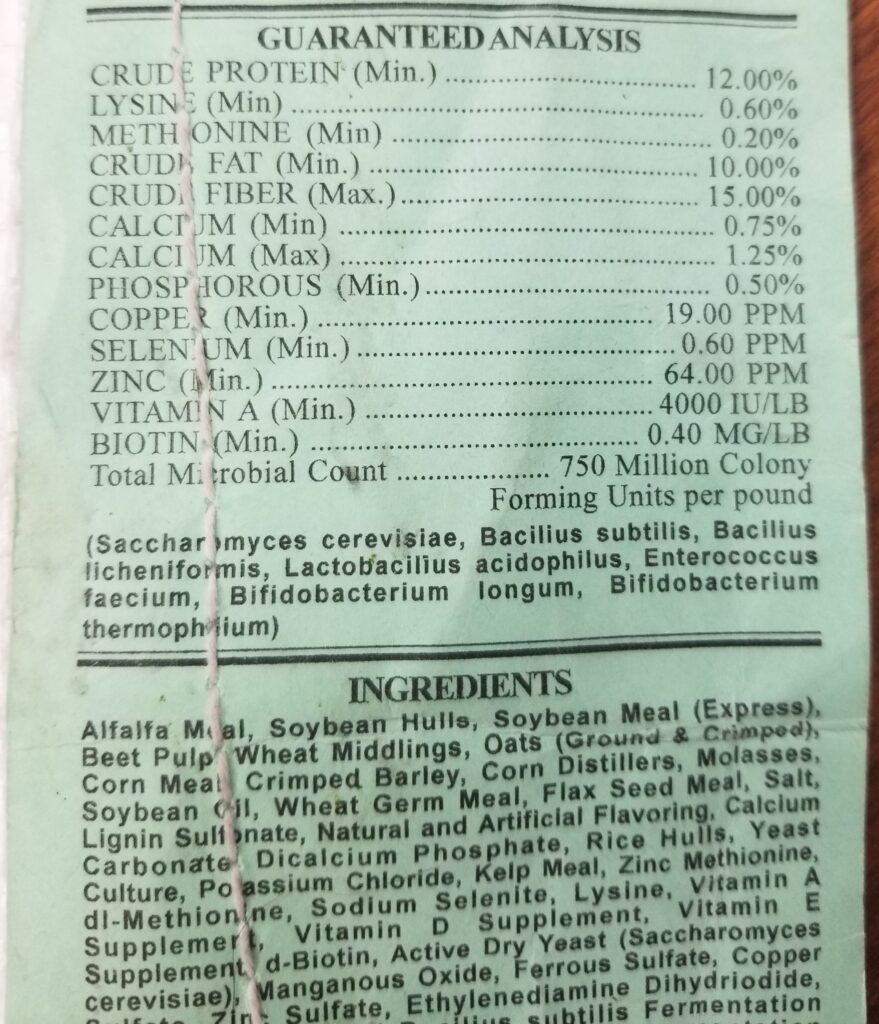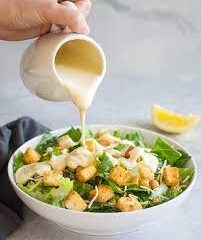Recognizing a Bad Feed Tag

This will be a “part deux” to the “Feed Tag Bingo” post. We’ll be looking at an actual feed tag and pointing out the games feed producers play with feed tags.
The tag in question is from a rather popular local mill in my area and is for their “12% Performance Horse Feed”. Based on the guaranteed analysis the name is fitting. It is indeed a 12% protein, 10% fat horse feed so no problem there. The biggest problem I have is that the people at this mill are telling horse owners that, based on the guaranteed analysis, this feed will provide the same performance and more expensive feeds like Purina Healthy Edge for a much lower price. This is the point where my problem starts.
What’s Not on the Tag
Although this local mill has been churning out feeds for multiple species for nearly 75 years none of their mill employees have any experience with horses. They don’t keep horses, they don’t ride horses and none of them have any academic or clinical background in equine nutrition. Does this mean their horse feed is bad? Not necessarily but it’s much less costly to follow a recipe reverse engineered from another company’s research than to do your own.
In keeping with the theme above this mill has no testing facilities of their own herd nor have they conducted any field trials on any horses. Essentially they are experimenting with their customer’s horses.
This is a multispecies mill which means that their horse feed is being processed on the same equipment as their dairy cow, sheep and goat feeds. All of these feeds contain ingredients that are harmful to horses. Not a problem if cleaning protocols are followed but it doesn’t take much rumensin to cause lasting damage to a horse.
This mill does not have a testing lab on site so it is impossible for them to test the nutrient values or quality of the commodities that they are using. Since I’m part of the local feed mill world I can say with all confidence that they are shopping for the best price on ingredients. Always keep in mind that when one of the major feed mills rejects a load of corn for high levels of mycotoxin SOMEBODY is buying it as a feed ingredient.
I’m using a local mill for these examples but the same observations apply to larger regional and even national mills. In short not all feeds are created equal.
What IS on the TAG
If we look at the tag pictured you will see that the guaranteed analysis indicates 12% protein and 10% fat. This is the extent of the similarity to Purina Healthy Edge that this mill sells this feed to replace.
Lysine is next on the list at 0.60% versus Healthy Edge at 0.90%. Doesn’t look like much of a difference but Healthy Edge has 30% more Lysine and as we should all know by now that Lysine is the limiting amino acid in horses and without enough lysine none of the other protein is activated.
Let’s stay with lysine. If we look on the list of ingredients for this tag we see “lysine” but there is no mention of “L-Lysine” anywhere. A horse requires “L-lysine” in it’s diet. Lysine will show up on an analysis to pass the GA test but the simple fact that it’s in the feed doesn’t mean that it’s helping anything because it is not.
Crude Fiber is 15% versus Healthy Edge at 18%. Is this a big deal? I can’t tell because this tag doesn’t list ADF and NDF levels so it’s hard to tell if the fiber in this feed is mostly digestible or if it’s just “roughage”.
Healthy Edge has 50% more calcium, four times the copper, four times the zinc.
Hallelujah! This feed has 25% more Vitamin A but no guarantees on D or E.
This feed DOES list methionine and biotin on the GA while Healthy Edge has neither but since the lysine in this feed is highly deficient those additional amino acids do not good. L-lysine is an expensive ingredient while lysine, methionine and biotin are cheap.
By the way, if you are spending a fortune on biotin supplements your local feed store can sell you a 50 pound bag for around $25.
Probiotics! Whoop-dee-do. We all know that probiotics don’t do anything for a healthy horse and 750 million CFU per pound is a drop in the bucket for a horse that requires probiotic support. The source is right on the list of ingredients, “active yeast” also known as “brewer’s yeast”. Cheap stuff in bulk.
These last few items are examples of “tag dressing”. They bulk up the tag without really adding any substance.
Where is the Sugar and Starch
Healthy Edge has guaranteed max sugar and starch levels on the feed tag. Where are they on this feed?
Based on the list of ingredients, corn, oats, distillers grain and barley my guess is that you probably wouldn’t want to feed this to an IR or PSSM horse.
Hopefully this will give you some idea of the questions to ask and facts to consider when playing “feed tag BINGO”.
Remember “Feed tags don’t lie but liars use feed tags!”
Jim the feed guy 2021



